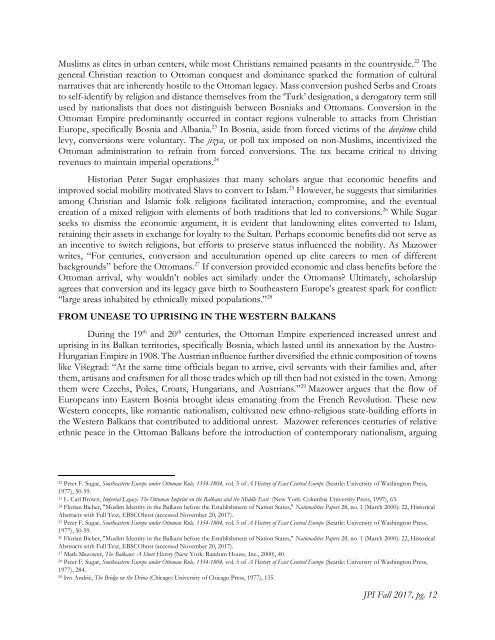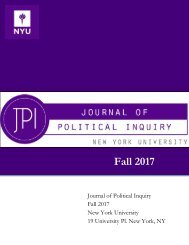JPI Spring 2018
You also want an ePaper? Increase the reach of your titles
YUMPU automatically turns print PDFs into web optimized ePapers that Google loves.
Muslims as elites in urban centers, while most Christians remained peasants in the countryside. 22 The<br />
general Christian reaction to Ottoman conquest and dominance sparked the formation of cultural<br />
narratives that are inherently hostile to the Ottoman legacy. Mass conversion pushed Serbs and Croats<br />
to self-identify by religion and distance themselves from the ‘Turk’ designation, a derogatory term still<br />
used by nationalists that does not distinguish between Bosniaks and Ottomans. Conversion in the<br />
Ottoman Empire predominantly occurred in contact regions vulnerable to attacks from Christian<br />
Europe, specifically Bosnia and Albania. 23 In Bosnia, aside from forced victims of the devşirme child<br />
levy, conversions were voluntary. The jizya, or poll tax imposed on non-Muslims, incentivized the<br />
Ottoman administration to refrain from forced conversions. The tax became critical to driving<br />
revenues to maintain imperial operations. 24<br />
Historian Peter Sugar emphasizes that many scholars argue that economic benefits and<br />
improved social mobility motivated Slavs to convert to Islam. 25 However, he suggests that similarities<br />
among Christian and Islamic folk religions facilitated interaction, compromise, and the eventual<br />
creation of a mixed religion with elements of both traditions that led to conversions. 26 While Sugar<br />
seeks to dismiss the economic argument, it is evident that landowning elites converted to Islam,<br />
retaining their assets in exchange for loyalty to the Sultan. Perhaps economic benefits did not serve as<br />
an incentive to switch religions, but efforts to preserve status influenced the nobility. As Mazower<br />
writes, “For centuries, conversion and acculturation opened up elite careers to men of different<br />
backgrounds” before the Ottomans. 27 If conversion provided economic and class benefits before the<br />
Ottoman arrival, why wouldn’t nobles act similarly under the Ottomans? Ultimately, scholarship<br />
agrees that conversion and its legacy gave birth to Southeastern Europe’s greatest spark for conflict:<br />
“large areas inhabited by ethnically mixed populations.” 28<br />
FROM UNEASE TO UPRISING IN THE WESTERN BALKANS<br />
During the 19 th and 20 th centuries, the Ottoman Empire experienced increased unrest and<br />
uprising in its Balkan territories, specifically Bosnia, which lasted until its annexation by the Austro-<br />
Hungarian Empire in 1908. The Austrian influence further diversified the ethnic composition of towns<br />
like Višegrad: “At the same time officials began to arrive, civil servants with their families and, after<br />
them, artisans and craftsmen for all those trades which up till then had not existed in the town. Among<br />
them were Czechs, Poles, Croats, Hungarians, and Austrians.” 29 Mazower argues that the flow of<br />
Europeans into Eastern Bosnia brought ideas emanating from the French Revolution. These new<br />
Western concepts, like romantic nationalism, cultivated new ethno-religious state-building efforts in<br />
the Western Balkans that contributed to additional unrest. Mazower references centuries of relative<br />
ethnic peace in the Ottoman Balkans before the introduction of contemporary nationalism, arguing<br />
22<br />
Peter F. Sugar, Southeastern Europe under Ottoman Rule, 1354-1804, vol. 5 of A History of East Central Europe (Seattle: University of Washington Press,<br />
1977), 50-59.<br />
23<br />
L. Carl Brown, Imperial Legacy: The Ottoman Imprint on the Balkans and the Middle East (New York: Columbia University Press, 1997), 63.<br />
24<br />
Florian Bieber, "Muslim Identity in the Balkans before the Establishment of Nation States," Nationalities Papers 28, no. 1 (March 2000): 22, Historical<br />
Abstracts with Full Text, EBSCOhost (accessed November 20, 2017).<br />
25<br />
Peter F. Sugar, Southeastern Europe under Ottoman Rule, 1354-1804, vol. 5 of A History of East Central Europe (Seattle: University of Washington Press,<br />
1977), 50-59.<br />
26<br />
Florian Bieber, "Muslim Identity in the Balkans before the Establishment of Nation States," Nationalities Papers 28, no. 1 (March 2000): 22, Historical<br />
Abstracts with Full Text, EBSCOhost (accessed November 20, 2017).<br />
27<br />
Mark Mazower, The Balkans: A Short History (New York: Random House, Inc., 2000), 40.<br />
28<br />
Peter F. Sugar, Southeastern Europe under Ottoman Rule, 1354-1804, vol. 5 of A History of East Central Europe (Seattle: University of Washington Press,<br />
1977), 284.<br />
29<br />
Ivo Andrić, The Bridge on the Drina (Chicago: University of Chicago Press, 1977), 135.<br />
<strong>JPI</strong> Fall 2017, pg. 12
















